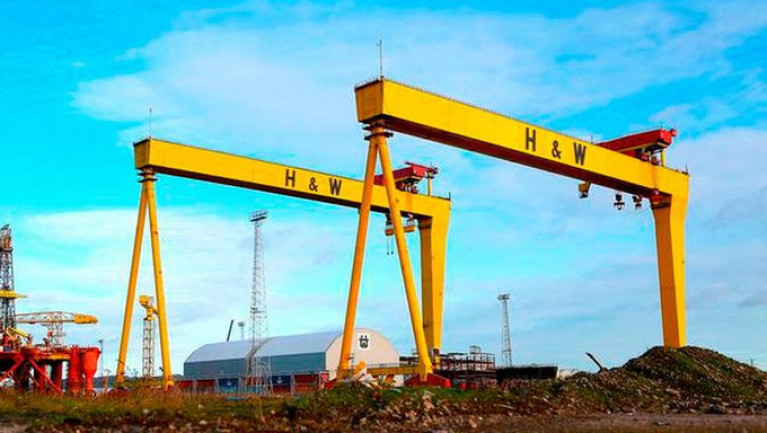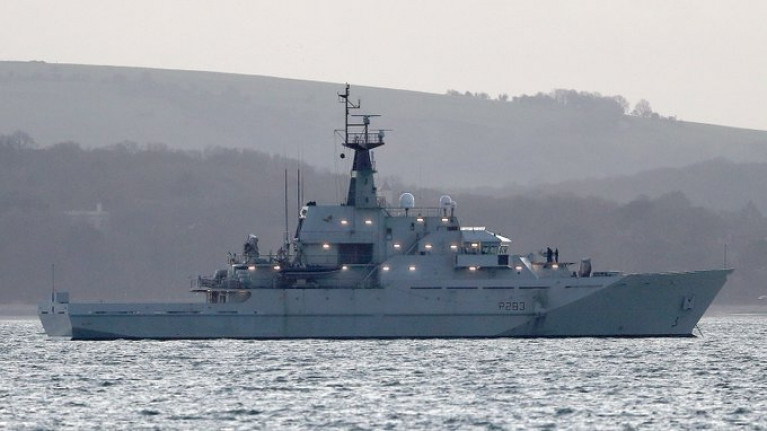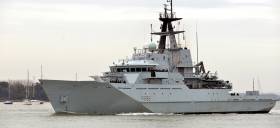Displaying items by tag: UK Royal Navy
Merseyside Shipyard Among UK Facilities Awarded Contracts to build Units for Royal Navy’s Type 26 Frigates
The Wirral Peninsula on the Irish Sea is where Birkenhead based shipbuilder, Cammell Laird along with North Sea based A&P Tyne have been awarded contracts by BAE Systems to build units for the UK Royal Navy’s Type 26 /City class frigates.
The advanced anti-submarine warfare vessels which Afloat reported began with the first ship, HMS Glasgow, are being constructed at BAE Systems’ sites in Govan, Scotland, but will incorporate units built from both shipyards.
A&P Tyne, a shipyard which boasts the largest fabrication facilities on the east coast of England, has built four lower units for Ship No.3, HMS Belfast, all of which were delivered earlier this year. As for the Ship No.2, Afloat highlights this is HMS Cardiff.
Cammell Laird which operates one of the largest construction halls in Europe, is building units for Ship No.4, HMS Birmingham, which will also be joining all of these units together.
The development marks the latest milestone in a hugely productive history of collaboration with BAE Systems, having previously supported the build of the Astute and Dreadnought class submarines, manufactured substantial parts of Her Majesty’s QEC Class Aircraft Carriers (see, Afloat’s Appledore Irish Naval Service story) and delivered the Type 45 Power Improvement Project (PIP).
Mike Hill, Managing Director at Cammell Laird said: “Cammell Laird has a long standing history of collaboration with BAE Systems and we are delighted to be working together to deliver the next generation of anti-submarine warfare.
“With our ability to work alongside our colleagues at A&P Tyne throughout the build process, taking the transfer of knowledge and vital experience is proving to be delivering both acceleration to the programme and significant efficiencies savings throughout.”
The Type 26 Frigates are designed for anti-submarine warfare and will replace the Type 23, with the first due to enter service later this decade.
David McGinley, Chief Executive Officer at A&P Group and Cammell Laird, said: “We have a proud track record when it comes to partnership working and delivering projects of vital national importance.
“Our commitment to the armed forces and our defence capabilities lies at the heart of our business and everything we do.”
Apprentices from both A&P and Cammell Laird have also been working on the project, a point of pride for everyone involved.
David added: “We’re fiercely and unashamedly proud to be able to play even a small role in the lives of the communities in which we’re based. And because this is the next generation of Royal Navy vessel, it’s only fitting that the next generation of our workforce should be working on it.”
First Foreign Naval Ship to Visit Ireland this Year takes Place During New St. Brigid's Day Bank Holiday Weekend
HMS Brocklesby became the first foreign naval ship to visit Ireland this year with an arrival in Dublin Port this morning, writes Jehan Ashmore.
The visit of the UK Royal Navy minehunter in the Irish capital also takes place during the course of this year's new St. Brigid's Day Bank Holiday Weekend.
The 'Hunt' class Mine Counter Measures Vessel (MCMV) departed Britain's biggest naval base in Portsmouth, Hampshire and is on a courtesy call which continues until the bank holiday Monday.
This year also marks the 40th year since HMS Brocklesby was commissioned in 1983 and the 60m minehunter is currently under the command of Lieutenant Commander Matthew Teare. In June 2021 he assumed Command of MCM2 Crew 2 on HMS Cattistock followed by HMS Brocklesby in November.
HMS Brocklesby is usually based in the Middle East and has assisted with operations in Iraq and Libya. Among the ship's deployments has included three years in the Persian Gulf from where HMS Brocklesby returned to its homeport of Portsmouth in 2021.
The minehunter's primary purpose is to seek out and neutralise enemy mines using Sonar technology. This involves a combination of highly trained Mine Clearance Divers and the Seafox unmanned underwater vehicles dispatched from a glass-reinforced plastic hull, one of the largest of its kind and which helps protect the 625 gross tonnage vessel from mines.
During the Dublin bound passage of HMS Brocklesby (M33) through the English Channel on Wednesday night, Afloat tracked the minehunter while offshore of Portland Bill, Dorset.
Further to the south is the Channel Islands where in Jersey, HMS Brocklesby last year paid a visit as part of Queen Elizabeth's Platinum Jubilee celebrations.
The 17 knot capable minehunter also has a secondary role as an offshore patrol vessel (OPV) which has tasks in undertaking coastal patrol duties around the UK and abroad.
As of yesterday the Channel Islands had HMS Severn (P282) a River-Class OPV in waters off Jersey as well as Guernsey, having departed Plymouth in Cornwall.
HMS Brocklesby has previously called to Dublin and likewise of HMS Severn when Afloat.ie reported of a visit in 2017.
On arrival in the port, HMS Brocklesby made a transit through the Thomas Clarke (East-Link) Toll-Lift Bridge from where the minehunter proceeded upriver to berth on the Liffey at Sir John Rogerson's Quay.
The berths along this south quay have traditionally for years been used by numerous naval ship calls. As for larger vessels they occupy berths in the main more modern port estate located east of the toll-bridge.
HMS Brocklesby is to conclude the visit with a scheduled departure on Monday morning.
Parent company of Harland & Wolff has said it is ready to bid for an estimated £30m 10-year deal to dry-dock, repair and maintain two giant UK Royal Navy 'Queen Elizabeth' class aircraft carriers.
InfraStrata shut down large parts of its Belfast dockyard for four months last year to carry out maintenance and upgrades to ensure the shipyard was in a strong position to bid for the lucrative contract.
The yard will face opposition from one other facility, Rosyth on the east coast of Scotland, where the two 'QE' carriers were built.
More from the Belfast Telegraph.
As Afloat previously reported the pair of QE aircraft carriers, had involved sections of the vessels to be built throughout various yards, among them Appledore Shipyard.
The north Devon facility which built a quartet of OPV90 'P60' class for the Irish Naval Service, was last year acquired by Infrastrata.
UK Royal Navy's Standby Patrol 'Irresponsible' - Irish MEP Barry Andrews
The Irish MEP Barry Andrews has criticised the British government's plan to put Royal Navy patrol boats on standby to protect UK waters in the event of a no-deal Brexit.
"I think it is irresponsible. It's completely inappropriate. It's 19th century gun boat diplomacy," he said.
The British Ministry of Defence said four ships were ready for "robust enforcement" when the transition period ends as fishing continues to be one of the major sticking points in negotiations.
Mr Andrews, a member of the European Parliament Committee on International Trade, said the announcement was made the day after the European Commission published a regulation that would have allowed for reciprocal EU-UK access to each other's fishing waters.
"We have an approach to a modern free trade deal and a responsible attitude in the event of no-deal and the UK decides to deploy naval vessels.
"It is very disappointing to see this and it doesn't bode well for an accord being reached in the next 48 hours," the Fianna Fáil MEP said.
The Department of Defence told RTÉ that fisheries protection "in accordance with the state's obligations as a member of the European Union" is the main day-to-day role of the Irish Navy.
It said 90% of the patrols it carries out "on a regular and frequent basis" are dedicated to it. The patrols cover Irish waters from the shoreline to the outer limits of the Exclusive Economic Zone.
For much more reports RTE News
Underway is an investigation following an incident between a UK Royal Navy warship and a Killybegs-registered trawler off the Donegal coast.
An Air Corps maritime patrol aircraft, reports DerryNow, was dispatched and two Irish Naval Service ships placed on standby after the skipper of the Killybegs-based fishing vessel, the Marliona, reported that a UK frigate ordered him to leave the area where he was fishing 60 miles off the Irish coast.
It is understood that HMS Lancaster hailed the fishing vessel on Tuesday morning, informing the skipper they were commencing a joint operation with a submarine which would continue over the next three days.
A maritime aircraft was sent to monitor the area where the UK warship was operating and two Irish naval vessels were redeployed.
More details on the naval-fishing incident by clicking here.
A UK Royal Navy warship is sailing to north Wales (today) to take part in the annual Armed Forces Day celebrations.
HMS St Albans, reports NorthWalesLive, will arrive at the Port of Holyhead to take part in a series of events .
As part of North Wales Armed Forces Day on Saturday, 250 members of the public will enjoy a free tour of the Type 23 frigate which is the UK's only "on-duty warship".
The ship's 185 strong crew will also take part in a special ceremony to mark awarding the Freedom of Anglesey to the Royal Navy Submarine Service.
This honour will take place in Holyhead and will be followed by a civic reception and a memorial service, commemorating the loss of HMS Thetis in June 1939.
This will include a parade through the town of Holyhead by members of the Armed Forces community and veterans.
Continue here to read more and on details of events.
UK's Royal Navy Mersey Visits Liffey Prior to 'Brexit' Contingency Role
#navalvisitors - A UK Royal Navy vessel deployed to patrol the Strait of Dover, due to the rise in recent months of migrants trafficked on boats from France, is currently visiting Dublin Port, writes Jehan Ashmore.
On Tuesday, HMS Mersey arrived to berth next to the Tom Clarke (East-Link) toll-lift bridge. The call to the capital of the Batch 1 River Class offshore patrol vessel (OPV) is for crew rest and recreation. The newest of the orginal River class OPV's will not be open to public tours.
HMS Mersey had sailed from Portsmouth, where it is stationed in the RN's main base, however last month the UK Home Office requested the Ministry of Defence to use the vessel to assist the UK Border Force. The OPV is only one of two available to the Royal Navy, the other, HMS Tyne also sailed from Portsmouth last month to conduct routine fishery protection and patrols within UK waters.
During the media coverage of migrants, Afloat noted a UK Border Force patrol cutter featured in footage when docked in both Folkstone and at the Port of Ramsgate. The east Kent port, is very much the focus of the current ferry farce surrounding the British Government contract to award Seaborne Freight £13.8m to run a service to Belgium in the event of a no-deal Brexit.
Brexit Contingency Funds role for OPV's
As part of the UK Government's Brexit contingency funds, according to Ships Monthly, £12.7m will enable the RN to increase its border security capability. This will see an increase in patrols from 200 to 600 days annually.
The funding follows the Defence Secretary decision to retain three Batch 1 OPV's. Prior to the announcement sisters of HMS Mersey, the Severn and Tyne had already been decommissioned, however they will be reactivated for a period of at least two years.
In addition arising from the Brexit contingency funding is notably the relocation of the River class from Portsmouth to each of the sisters namesake rivers. HMS Mersey is to be based in Liverpool, the Severn heads to Cardiff while the Tyne goes to Newcastle.
Another River class sister, HMS Clyde patrols waters off the Falkland Islands and operates in the South Atlantic Ocean. There are rumours this sister is to began a new career with the Brazilian Navy.
River Class Patrol Vessel HMS Severn On the Liffey
#RiverClass – Making a call to Dublin Port today is a UK Royal Navy ‘River’ patrol class vessel that is to remain in the capital for a three-day visit, writes Jehan Ashmore.
HMS Severn is one of the River class quartet and represents the second built by Vosper Thornycroft at their Woolston yard. The patrol ship is deployed up to 200 miles offshore in the Atlantic. This is to ensure that fishing boats and trawlers stick to UK and EU fisheries laws.
The OPV can also be used from fire-fighting to disaster relief operations.
Likewise of two of her sisters HMS Tyne and HMS Mersey each have a crew of about 45 sailors. The crew work at least 275 days a year at sea to enforce internationally agreed fishing qoutas.
The River class have a 5,500 nautical mile range and have a speed of 20 knots. They are equipped with two gun weapons systems.
As for the final unit of the quartet, HMS Clyde operates around the Falkland Islands in the South Atlantic.
































































